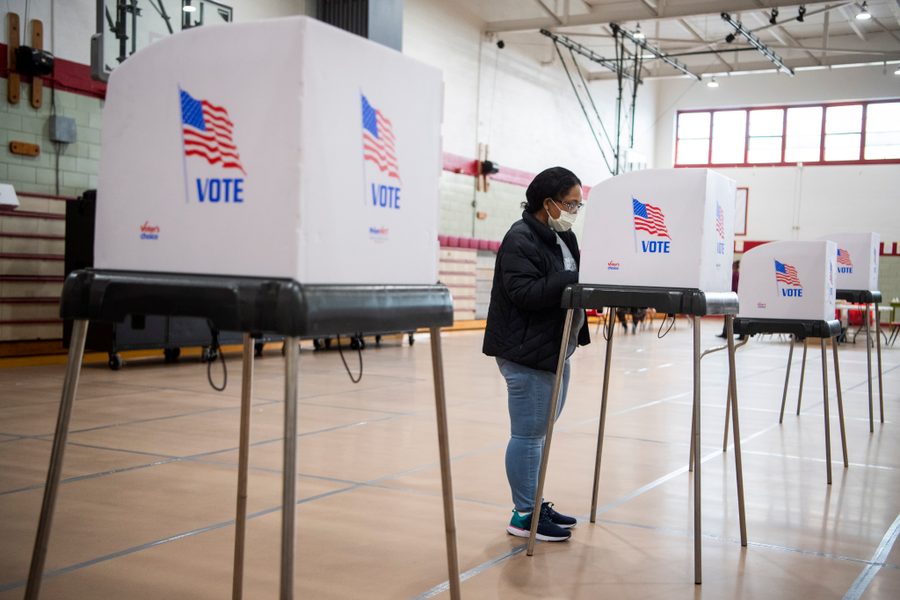The Case for Wearing a Mask and Voting In Person
In battleground states, vote by mail could contribute to Trump’s “red mirage” lead on election night.
Steven Hill

Joe Biden and the Democrats are walking into a trap in the key battleground states that will decide the upcoming presidential race, as well as key Senate elections. That trap is called “vote by mail” or “absentee voting.”
In normal times, I am a proponent of having a vote by mail option. But these are not normal times. For the November 3 election, it makes much more sense to promote “early voting” in battleground states rather than vote by mail. If they want to be sure that their votes will count, able-bodied voters in competitive races should not mail in their ballots. Instead, they need to show up in person to vote, either before or on Election Day. Despite the dangers of the pandemic, voters who do not have a compromised immune system need to do the heroic act of standing in line with their masks on, just like we stand in line at the grocery store.
The fact is, even if there was no whiff of electoral fraud in the air, vote by mail has led to the loss of millions of ballots due to errors on the part of the voters, election administrators and the postal service. Democratic voters, especially minority voters and young people, are disproportionately hurt. The data is overwhelmingly clear on this, yet Democrats are ignoring it at their peril.
In the recent New York primary elections, tens of thousands of mailed ballots were never counted due to bureaucratic mistakes. Some ballots were postmarked after the election or never postmarked at all by the postal service, making them invalid under state law. Others were disqualified because voters didn’t sign on an easy-to-miss signature line on the back of the ballot envelope. Another 32,000 absentee ballots were mailed to voters so late that they couldn’t return them in time to be counted. Just in New York City’s Democratic presidential primary, over 400,000 mail-in ballots were received, but election officials invalidated more than 84,000 — over a fifth of those ballots.
Across the country, in 24 primary elections this year, more than 500,000 mail-in ballots were rejected. In Pennsylvania alone, mail ballot problems prevented 92,000 people from casting a valid vote (Donald Trump won Pennsylvania in 2016 by just 44,000 votes). An MIT study of the 2008 presidential election uncovered that nearly 4 million voters said they requested mail ballots but never received them. Another 2.9 million ballots that were sent out did not make it back to election officials, and about 800,000 were rejected due to voter, election official or postal service errors.
Voters in many polling stations benefit from technology like “error notification,” which alerts the voter if she has made a disqualifying mistake on her ballot. But you don’t have that with absentee voting. “The pipeline that moves mail ballots between voters and election officials is very leaky,” the study concluded.
With voting by mail surging for this election, the number of rejected mail-in ballots has been estimated to easily surpass a million. And those will overwhelmingly be voters for Joe Biden and Democratic Senate candidates. Far more Biden voters are planning to vote by mail than Trump voters. One recent study found that nearly half of Democrats said they intend to vote by mail, compared to just 28% of Republican and independent voters. Just as important, the negative impacts will hit minority voters and young people hardest. A study of Georgia’s 2018 midterm elections found that mail-in ballots of “younger, minority and first-time voters are most likely to be thrown out.” A study of Florida’s 2018 election determined that mail-in ballots “cast by Black, Hispanic, and other racial and ethnic minorities were more than twice as likely to be rejected as … ballots cast by White absentee mail voters.”
That means hundreds of thousands of more Democratic votes will be thrown out than Republican votes. The possibility of widespread disenfranchisement from mail-in ballots is real, yet the Democrats have been ignoring this and promoting vote by mail. That is a big mistake.
To be clear, most elections are won by large margins, such as those in heavily Democratic or Republican states or districts, so these voting failures will not overturn those election results. But in the battleground states, such as Pennsylvania, Wisconsin, Michigan, North Carolina or Florida, this could well be the deciding factor in a close presidential or Senate election. Add the potential for partisan interference by the U.S. Postal Service, since President Donald Trump’s recently appointed postmaster general is a big GOP campaign donor, or even partisan Secretaries of State overseeing the elections, and you arrive at the disturbing possibility of millions of mailed-in ballots potentially never being counted, and hundreds of thousands of Democratic voters being disenfranchised.
Where is the Biden campaign and Democratic Party leadership on this? The Democratic National Committee has been pushing vote by mail to the point that some activists have become nervous. “I do worry about some of the vote-by-mail push,” said Steve Schale, a Florida-based Democratic strategist who works with Unite the Country, a pro-Biden super PAC. “We should help people vote in the way they’re most comfortable voting. We shouldn’t force them into vote-by-mail.”
Red mirage
But it actually gets worse. Even if you mail in your ballot well before election day, and it arrives in time, in a number of states you still have a problem: In most states, election officials do not start counting those ballots right away. Of greatest concern, the swing states of Michigan, Pennsylvania, Wisconsin and New Hampshire do not even allow mail-in or absentee ballots to be processed or voters’ signatures verified before election day.
So imagine this Nightmare Scenario: With so many more Biden supporters voting by mail, that means in a close election it is possible President Trump will be ahead on election night, based on partial returns in a number of battleground states (a scenario that has been called “a red mirage”). President Trump already has furiously deployed his Twitter soapbox to discredit mailed in ballots as fraudulent (even though he himself has often voted absentee). He also has hinted that he may not accept the election results. During Florida’s gubernatorial and senate elections in 2018, as absentee ballots were counted and the Democratic candidates narrowed the vote gap to a sliver, Trump tweeted that “large numbers of new ballots showed up out of nowhere, and many ballots are missing or forged.”
So what happens if Trump declares victory on election night, and then tries to dispute any “late” uncounted ballots, both in the courts and in the free-for-all of public opinion?
Suddenly the nation will be gripped in a replay of Bush v. Gore in the 2000 election — but in several battleground states. Recall the partisan clashes and low-intensity intimidation that occurred in 2000 on the picket lines outside the hand counts in Florida. During the course of a five-week legal war over hanging chads and the rules for ballot counting, protesters in combat fatigues held aloft signs saying things like “Bush or Revolution,” with “revolution” in bloody scrawl. Threatening letters were mailed to judges, including one with an illustration of a skull and crossbones. When George W. Bush was finally declared president, thousands of Floridians’ ballots still sat in piles across the state, not properly counted, because the U.S. Supreme Court aborted the process.
Now imagine the unleashing of those toxic passions in multiple states. During the run-up to this 2020 election, already an alarming number of protesters have been killed in the tensions swirling around the protests amid police over-reaction. This has all the makings of a constitutional crisis looming like a Category 5 hurricane just offshore. Once the election is thrown into the hands of a conservative-majority Supreme Court, as the nation saw in Bush v. Gore, “five votes beats a reason any day.” The recent passing of Ruth Bader Ginsburg tilts the court even more toward pro-Trump partisanship.
Preventing a constitutional crisis
How can we prevent this election meltdown? One important step is that voters in most battleground states should forget voting by mail. Instead, those voters should consider putting on their masks and standing in line to vote, either before or on election day. That way, their vote will be tabulated immediately by the voting equipment. Yes, it’s riskier for personal health, but in the current climate, vote by mail is riskier for our representative democracy. It’s a terrible choice to have to make in the middle of a pandemic. But unless you have a compromised immune system, you should not mail in your ballot. Instead, you should refocus on making a plan to do the heroic act of showing up to vote.
Fortunately, a number of states allow you to vote in person before election day. Spreading out voting over many days and weeks will cut down considerably on long lines. Other states allow you to drop off your absentee vote with election officials before election day, which is preferable to mailing it in — but the problem with that strategy is that your absentee ballot may not get counted before the tally is released on election night. It all depends on the election procedures in each state, which vary widely.
For example, in the battlegrounds of Wisconsin, Pennsylvania, Michigan, New Hampshire and Iowa, the counting of dropped-off absentee ballots cannot begin before election day. By election night, many of those ballots will likely still lie uncounted. It depends on how overwhelmed the voting bureaucracy is, or even the whim of partisan election officials. In those states, Biden voters need to show up in person wearing their masks and vote. Don’t even drop off your ballot before election day, because your ballot will not be counted until after the election, and that will contribute to the “red mirage.”
But in other battleground states — notably Florida, North Carolina, Ohio, Colorado, Nevada and Arizona—election officials are allowed to count early absentee ballots before election day, and then release those vote totals right after the closing of the polls on November 3. These states also open vote centers many days or weeks before the polls, where any voter can immediately vote. In these states, voters with absentee ballots should drop them off early in an official dropbox or at one of the vote centers, rather than mailing them. Even better would be to show up early with your mask on and vote at one of the vote centers.
Some Democrats and their allies are starting to figure out the “mail ballot dead end” they have steered themselves into. Rep. Alexandria Ocasio-Cortez (D-N.Y.) recently tweeted that she will be “voting early and in person.” Georgia leader Stacey Abrams and her voter empowerment group Fair Fight are encouraging voters to “make a plan and vote as soon as possible.” They emphasize voting early either in person, using an official drop-off box, or by mail. Also, the deal struck by NBA players with team owners to use their facilities as sites for early voting with enough room for social distancing is a step in the right direction.
But these efforts could well be ineffective for those voters who live in one of the swing states that will not count absentee ballots until election day. Those voters run the risk of their ballots not being included in the election night tally, which in turn will contribute to the “red mirage” of Trump falsely appearing to lead and immediately declaring victory. Cue constitutional crisis, 2020.
We can best safeguard our democracy this November by utilizing early voting and, if necessary, showing up to vote with our masks, in as many battleground states as possible. The United States has reached such a perilous state that this simple act has become heroic.
As a 501©3 nonprofit publication, In These Times does not oppose or endorse candidates for political office.
Steven Hill is co-founder of FairVote and the author of seven books, including“10 Steps to Repair American Democracy” and “Fixing Elections: The Failure of America’s Winner Take All Politics”. His opinions are his own.







